Porous Metallic Tooling May Improve the Productivity
White Papers
While significant advances have been made in the design and capabilities of plastic molding machines during the last quarter century, little has changed in the materials and processes used to manufacture injection molding tools.
Two major issues that prevail with current tooling include (1) the venting of gases generated during the molding process, and (2) thermal management of the molding process itself.
Traditional methods of dealing with the venting problem have had limited effect. Trapped gases still cause quality problems such as burning, produced by compressed gases that impede the flow of molten resin in a cavity pocket, and short shots, caused by low injection pressure and /or gases trapped in pocket areas of the tool.
In terms of thermal management, manufacturers still struggle with uniformly removing heat from all areas of the die cavity during the process cycle. Current tooling and cooling methods make thermal management difficult because the amount of heat eliminated depends on thermal conductivity of the mold material, the coefficient of heat transfer of the cooling medium, the temperature difference between the material and the cooling medium, and the area of the heat-transmitting surface.
Designing a tool for effective cooling remains difficult because of the complex thermal management issues involved. Since the plastic injection molded part must be cooled sufficiently to hold its shape and dimensions before ejection, the production cycle is detrimentally affected, and the capacity of the injection molding machine reduced if cooling is not well controlled.
Porous Metallic Tooling
The universal problems of venting can be minimized or solved and productivity increased significantly through the use of porous metallic molds. Carpenter Powder Products (CPP) has demonstrated the feasibility of manufacturing porous tooling with controlled porosity levels from stainless steel powder. Tooling or molds can be made with interconnected, uniformly dispersed porosity levels, including predetermined pore size and distribution.
Powder metallurgy preforms of the specified material and the subsequent finished machine tooling are produced by combining powder metallurgy technology with a new and unique rapid consolidation metal powder (RCMP) process. The combined technologies produce a porous tooling material which can which can minimize or eliminate the venting problem in plastic injection molding. In addition, this material, when combined with an advanced cooling concept, has allowed manufacturers to compress cooling cycles by as much as 50%.
Plastic injection molders have found that porous tooling manufactured by these new process technologies along with improved tool design, have permitted them also to increase productivity, improve quality and reduce costs significantly.
Powder metallurgy preforms with controlled porosity can be manufactured from monolithic alloys or bimetallic alloys (porous and solid combinations) when, for instance, a superior surface finish of the molded part is important. Pores can be controlled from 3 microns and higher within a tool, and finished tooling can range from 80% to 95% dense.
Although porous, this tooling has more than enough strength needed to withstand the loads encountered in plastics injection molding – typically ranging up to 140 MPa (20 ksi). The tensile strength of Type 420 stainless steel tooling at about 90% density with an average pore size of 25 microns, for example, has been measured at 760 MPa (110 ksi).
Unique Powder Process
Figure 1 – Schematic of rapid consolidation metal powder process for manufacturing porous tools.
– Schematic of rapid consolidation metal powder process for manufacturing porous tools.
The RCMP process uses gas atomized powder of any metallic alloy including tool steels, stainless steels and cobalt/nickel-base alloys. Screened powder is enclosed in a shaped container, degassed, sealed and consolidated by a unique quasi-isostatic hot forging process. The contained powder is heated to an appropriate temperature and forged at pressures up to 828 MPa (120 ksi). This rapid consolidation process is illustrated in Figure 1.
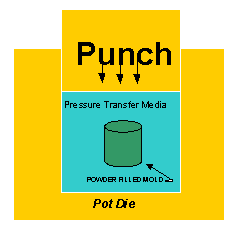
Porous tools can be tailor made with high strength and hardness and/or corrosion resistance, as required. The pores are connected to one another and to the surfaces of the tooling to allow gas flow throughout the tool. RCMP consolidation parameters determine the level of porosity as well as pore shape, size and distribution. Average powder particle size plays a significant role in controlling the average pore size (see Figure 2).
Figure 2 – Micrographs showing effect of average particle size changes on porous Type 420 stainless steel after rapid consolidation metal powder process.
– Micrographs showing effect of average particle size changes on porous Type 420 stainless steel after rapid consolidation metal powder process.
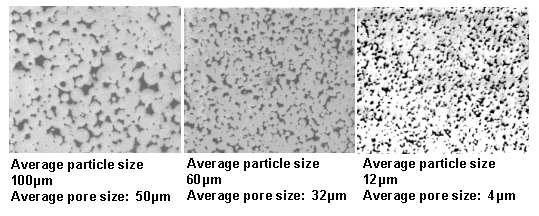
The hydraulic press employed with the RCMP process is capable of producing bimetallic/composite tools as well as a wide range of near-net shapes. Porous material made by the process can be used as inserts or as whole tools. In service, tooling of all sizes and cross section has demonstrated uniform behavior.
RCMP porous tools can significantly minimize or eliminate trapped gas that can occur in inadequately vented areas during plastic molding. Traditional methods of venting trapped gas such as parting line vents, vent plugs and pins are not always enough to free the large volumes of gases that some resins can generate. Both the porosity level and tool size can be controlled during RCMP consolidation to provide required venting capacity.
By eliminating trapped gases, porous tooling also can minimize or eliminate flow and knit lines, cancel shrink, improve fill through a vacuum assist, enhance surface appearance, and facilitate ejection. An illustration of the venting application is shown in Figure 3.
Figure 3 – Schematic showing venting of gas through porous tool.
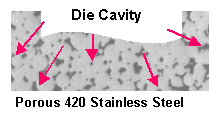
More Effective Cooling
Figure 4 – Schematic of CO2 cooling approach with a bimetal solid (A) and porous die configuration (B) and an all-porous die configuration.
– Schematic of CO cooling approach with a bimetal solid (A) and porous die configuration (B) and an all-porous die configuration.
In conventional injection molding, it is difficult to control the amount of heat lost through conduction and convection because of the variables (previously mentioned) that affect this process. As a result, designing effective tooling becomes a real challenge. Cycle time is increased because the heat must be removed by conduction. Water cooling in small cores is problematical, and good temperature control is tough to achieve.
These thermal management limitations can be overcome through the use of RCMP porous tools in conjunction with a newly patented gas cooling technology known as Toolvac®*. With this approach, liquid CO2 is forced through the pores of the porous tool, keeping it at a controlled temperature, thus providing efficient and even cooling.
After the liquid CO2 is introduced into the porous mold, a pressure drop causes it to vaporize. Due to the relationship between temperature and pressure, the energy content for CO2 in the gaseous phase is much higher than in the liquid phase. Consequently, thermal energy is absorbed from the surrounding porous mold system.
The extent of cooling can be managed by controlling the temperature and rate of the incoming liquefied gas. Since the gas is distributed by the porous tool, an even temperature can be achieved over the entire mold cavity surface. In contrast, uniform temperature cannot be maintained in the mold cavity with solid tools cooled by water channels. A schematic of the porous tooling approach can be seen in Figure 4.
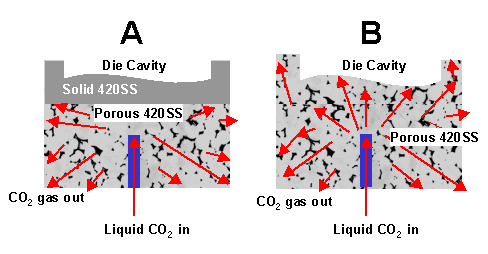
Porous tools, when combined with the liquid CO2 cooling concept, can provide a number of specific benefits for plastic injection molders. Faster heat dissipation and constant wall temperature, along with venting, can reduce cycle times and enhance product quality. In addition, ejection marks can be avoided and "the vacuum effect," or sticking, eliminated.
Parts molded with porous tooling generally have a matte finish, the quality of which can be predetermined by pore size. If surface finish is an issue, the porous tooling can be produced as a bi-metallic composite with a thin/thick solid tool surface bonded to the porous structure. When polished, this bonded surface gives an excellent finish. The composite tool thus can provide the desired degree of cooling together with a high quality finish on the molded part.
Overall, with the combined porous tooling technology and the liquid CO2 cooling, the plastic molder can increase productivity, improve product quality and gain valuable flexibility in designing complex parts. A simulation of this benefit is illustrated in Figure 5.
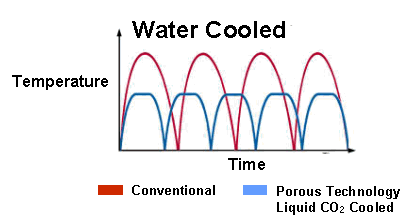
Figure 5 – Productivity enhancement achieved with porous tooling compared with conventional tooling.
– Productivity enhancement achieved with porous tooling compared with conventional tooling.
*Toolvac is a registered trademark of AGA Aktiebolag Corp.
* * *
Carpenter Powder Products is a subsidiary of Carpenter Technology Corporation that manufactures, sells and services gas-atomized nickel-, cobalt- and iron-based alloy powder products including PM and conventional tool steels.
***
By David J. Novotnak, Senior Materials Engineer
Carpenter Powder Products
A Subsidiary of Carpenter Technology Corp.
Bridgeville, PA